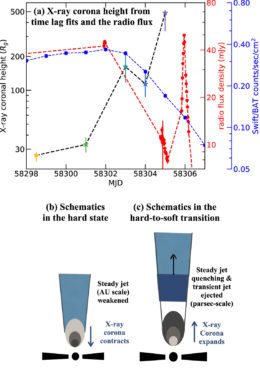Accreting, stellar-mass black holes are anything but predictable. A new study explores what’s happening as these feeding monsters erupt in violent outbursts and then settle down again.

This illustration shows some of the possible transient behavior of the gas flowing onto and away from a black hole in an X-ray binary. [NASA/JPL-Caltech]
An Unsteady Existence
Black hole X-ray binaries (BHXBs) consist of a stellar-mass black hole that siphons material from an ordinary companion star. As this material flows between the objects, it forms an accretion disk around the black hole. BHXBs shine in X-rays from the hot material of this disk, and from a mysterious corona — ultra-hot gas that exists in some unknown form above the disk.
BHXBs may accrete quietly and steadily much of the time, but on occasion, they undergo sudden outbursts, substantially brightening in X-rays. Unlike supermassive black holes, which evolve on extremely long timescales, stellar-mass black holes can change over just days or weeks — short enough for us to watch!
In a new study led by Jingyi Wang (MIT Kavli Institute), a team of scientists presents observations by NICER — an X-ray telescope installed on the International Space Station — of a BHXB throwing such a temper tantrum.
Reflections of a Transition
During an outburst, a BHXB undergoes state transitions, displaying changes in the X-ray luminosities and energies as either the corona or the disk takes over to dominate the emission. In addition to the X-ray changes, persistent radio emission from a slow and steady jet can be suddenly replaced by a short-lived radio flare that then subsides.
Despite many observations, we lack the details of what’s happening on small scales, close around the black hole. What form does the corona take? Does its size or extent change over time? What drives the state transitions? And how are the different components of this system — disk, corona, and jet — related, if at all?

The top plot (a) shows the inferred corona height (black line) over the span of the outburst. The radio emission, including the flare, can be seen in red. The bottom two diagrams show the authors’ picture of the geometry of the black hole, disk, and corona at two points during the state changes: during the rise from quiescence (b), and at the end of the outburst when the jet base is ejected (c). Click to enlarge. [Adapted from Wang et al. 2021]
A Connected Picture
Wang and collaborators show that the best explanation of NICER’s observations is that the height of the X-ray corona changes during the BHXB’s state transitions. They argue that the corona first contracts, and then rapidly expands during the outburst, preceding a radio flare by ~5 days.
Under the authors’ interpretation, these signs point to a neat picture of BHXB outbursts: a quietly accreting black hole has a disk and a steady jet, and the corona makes up the base of that jet. When the BHXB goes into outburst, it ejects that jet base as a bright knot in its final moments of outburst, before fading back to quiescence.
While this model isn’t yet definitive, this latest evidence points to a clear connection between the disk, jet, and corona of a BHXB. We’re sure to gain more insight ahead!
Citation
“Disk, Corona, Jet Connection in the Intermediate State of MAXI J1820+070 Revealed by NICER Spectral-timing Analysis,” Jingyi Wang et al 2021 ApJL 910 L3. doi:10.3847/2041-8213/abec79

